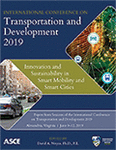International Conference on Transportation and Development 2019
Airline Network Design by Mixed Integer Linear Programming: The Case of Small Size Airlines
Publication: International Conference on Transportation and Development 2019: Innovation and Sustainability in Smart Mobility and Smart Cities
ABSTRACT
In this paper, two categories have been considered: optimizing economic issues in long-term planning of regional airline network structure; and the importance of changes in demand in different months of the year in airline network design. A mixed integer linear programming model has been provided in this study which, compared to previous models, considers issues such as capacity constraints and network planning issues. Moreover, the most important initiative of this article is entering two parameters: cost (non-profit) due to losing customers and expenditures of the unused capacity. These two parameters will help the model identify the best supply in each path. Various demand functions have been used in solving the model. Based on conducted analyses, using the expected value of monthly demand in comparison with high and low demand and seasonal changes in the network is optimized. The results of study also show that in times of high demand, the airline tends to aggregate passengers and increase density in hub paths.
Get full access to this chapter
View all available purchase options and get full access to this chapter.
REFERENCES
Adler, N. (2001). Competition in a deregulated air transportation market. European Journal of Operational Research, 129(2), 337-345. https://doi.org/10.1016/S0377-2217(00)00231-9
Alderighi, M., Cento, A., Nijkamp, P., & Rietveld, P. (2005). Network competition—the coexistence of hub-and-spoke and point-to-point systems. Journal of Air Transport Management, 11(5), 328-334. https://doi.org/10.1016/j.jairtraman.2005.07.006
Babic, D., & Kalic, M. (2012). Airline route network expansion: Modelling the benefits of slot purchases. Journal of Air Transport Management, 23(Supplement C), 25-30. https://doi.org/10.1016/j.jairtraman.2012.03.002
Babić, D., & Kalić, M. (2018). Modeling the selection of airline network structure in a competitive environment. Journal of Air Transport Management, 66(Supplement C), 42-52. https://doi.org/10.1016/j.jairtraman.2017.10.004
Barla, P., & Constantatos, C. (2000). Airline network structure under demand uncertainty. Transportation Research Part E: Logistics and Transportation Review, 36(3), 173-180. https://doi.org/10.1016/S1366-5545(99)00031-9
Burghouwt, G., Hakfoort, J., & Ritsema van Eck, J. (2003). The spatial configuration of airline networks in Europe. Journal of Air Transport Management, 9(5), 309-323. https://doi.org/10.1016/S0969-6997(03)00039-5
CAO.IR. (2011). Air transport annual statistic report. Retrieved from Iran Civil Aviation Organization, Tehran, Iran:
Fageda, X., & Flores-Fillol, R. (2015). A note on optimal airline networks under airport congestion. Economics Letters, 128(Supplement C), 90-94. https://doi.org/10.1016/j.econlet.2015.01.023
Fageda, X., & Flores-Fillol, R. (2017). Airport Congestion and Airline Network Structure The Economics of Airport Operations(pp. 335-359).
Flores-Fillol, R. (2009). Airline competition and network structure. Transportation Research Part B: Methodological, 43(10), 966-983. https://doi.org/10.1016/j.trb.2009.03.002
Freeman, L. C. (1978). Centrality in social networks conceptual clarification. Social Networks, 1(3), 215-239. https://doi.org/10.1016/0378-8733(78)90021-7
Hansen, M. (1990). Airline competition in a hub-dominated environment: An application of noncooperative game theory. Transportation Research Part B: Methodological, 24(1), 27-43. https://doi.org/10.1016/0191-2615(90)90030-3
Hsu, C.-I., & Wen, Y.-H. (2000). Application of Grey theory and multiobjective programming towards airline network design. European Journal of Operational Research, 127(1), 44-68. https://doi.org/10.1016/S0377-2217(99)00320-3
Jaillet, P., Song, G., & Yu, G. (1996). Airline network design and hub location problems. Location Science, 4(3), 195-212. https://doi.org/10.1016/S0966-8349(96)00016-2
Kawasaki, A. (2016). The Basic Model of Airline Network. In T. Naito (Ed.), Sustainable Growth and Development in a Regional Economy(pp. 109-128). Tokyo: Springer Japan.
Lian, J. I. (2010). Network dependency and airline competition – Consequences for remote areas in Norway. Journal of Air Transport Management, 16(3), 137-143. https://doi.org/10.1016/j.jairtraman.2009.07.007
Oum, T. H., Zhang, A., & Zhang, Y. (1995). Airline Network Rivalry. The Canadian Journal of Economics / Revue canadienne d'Economique, 28(4a), 836-857.
Silva, H. E., Verhoef, E. T., & van den Berg, V. A. C. (2014). Airline route structure competition and network policy. Transportation Research Part B: Methodological, 67(Supplement C), 320-343. https://doi.org/10.1016/j.trb.2014.05.012
Teodorović, D., Kalić, M., & Pavković, G. (1994). The potential for using fuzzy set theory in airline network design. Transportation Research Part B: Methodological, 28(2), 103-121. https://doi.org/10.1016/0191-2615(94)90020-5
Vaaben, B., & Larsen, J. (2015). Mitigation of airspace congestion impact on airline networks. Journal of Air Transport Management, 47(Supplement C), 54-65. https://doi.org/10.1016/j.jairtraman.2015.04.002
Yang, T.-H. (2010). A two-stage stochastic model for airline network design with uncertain demand. Transportmetrica, 6(3), 187-213.
Yang, T.-H., & Chiu, T.-Y. (2016). Airline hub-and-spoke system design under stochastic demand and hub congestion. Journal of Industrial and Production Engineering, 33(2), 69-76.
Yang, T.-H., & Huang, Y. (2015). Hub-and-spoke airline network design under competitive market. Journal of Industrial and Production Engineering, 32(3), 186-195.
Information & Authors
Information
Published In
International Conference on Transportation and Development 2019: Innovation and Sustainability in Smart Mobility and Smart Cities
Pages: 122 - 134
Editor: David A. Noyce, Ph.D., University of Wisconsin–Madison
ISBN (Online): 978-0-7844-8258-2
Copyright
© 2019 American Society of Civil Engineers.
History
Published online: Aug 28, 2019
Authors
Metrics & Citations
Metrics
Citations
Download citation
If you have the appropriate software installed, you can download article citation data to the citation manager of your choice. Simply select your manager software from the list below and click Download.
